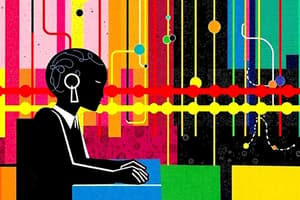Podcast
Questions and Answers
Which of the following best describes the focus of the 'Gestation of AI' period (1934-1955)?
Which of the following best describes the focus of the 'Gestation of AI' period (1934-1955)?
- Overcoming the limitations of simple neural networks
- The proposal of the first artificial neuron model and laying groundwork for neural network learning (correct)
- Development of rule-based expert systems
- The rise of the Digital Equipment Corporation in selling expert systems
What key concept did Alan Turing introduce in 1950 that remains a significant benchmark in the field of AI?
What key concept did Alan Turing introduce in 1950 that remains a significant benchmark in the field of AI?
- The concept of 'satisficing' in decision-making
- The 'Turing Test' as a measure of a machine's ability to exhibit intelligent behavior (correct)
- The framework for knowledge-based systems
- The back-propagation algorithm for neural networks
During the 'AI Winter' of 1966-1973, what critical limitation was exposed, hindering the progress of neural networks?
During the 'AI Winter' of 1966-1973, what critical limitation was exposed, hindering the progress of neural networks?
- The ethical concerns surrounding AI's potential impact on human uniqueness
- The lack of suitable programming languages for AI research
- The computational intractability of many AI problems and the limitations of simple neural networks (correct)
- The inability of AI to demonstrate capabilities in games, puzzles, and IQ tests.
Which advancement marked the 'return of neural networks' in the mid-1980s?
Which advancement marked the 'return of neural networks' in the mid-1980s?
How did the availability of very large datasets influence AI development starting in 2001?
How did the availability of very large datasets influence AI development starting in 2001?
What event marked deep learning's capability to extend its applications to various domains?
What event marked deep learning's capability to extend its applications to various domains?
Which of the following is an example of AI's impact on autonomous planning and scheduling?
Which of the following is an example of AI's impact on autonomous planning and scheduling?
What advancement in AI has significantly enhanced the accessibility of information across different languages?
What advancement in AI has significantly enhanced the accessibility of information across different languages?
In what area has AI demonstrated capabilities matching or exceeding those of expert doctors?
In what area has AI demonstrated capabilities matching or exceeding those of expert doctors?
What is a key capability that AI brings to the field of climate science?
What is a key capability that AI brings to the field of climate science?
Which of the following is a characteristic of an intelligent agent?
Which of the following is a characteristic of an intelligent agent?
What distinguishes a 'rational agent' from other types of agents?
What distinguishes a 'rational agent' from other types of agents?
Which of the following is the most crucial initial step in designing an intelligent agent?
Which of the following is the most crucial initial step in designing an intelligent agent?
How do 'model-based reflex agents' differ from 'simple reflex agents'?
How do 'model-based reflex agents' differ from 'simple reflex agents'?
What is the primary objective of a goal-based agent?
What is the primary objective of a goal-based agent?
In the context of intelligent agents, what does the 'performance measure' evaluate?
In the context of intelligent agents, what does the 'performance measure' evaluate?
Which type of agent uses a 'utility function' to measure preferences among different world states?
Which type of agent uses a 'utility function' to measure preferences among different world states?
What is the role of 'effectors' in an intelligent agent?
What is the role of 'effectors' in an intelligent agent?
Which of the following best defines an agent function?
Which of the following best defines an agent function?
What is the significance of an agent maintaining an internal state?
What is the significance of an agent maintaining an internal state?
Which of the following task environment properties presents the greatest challenge for designing an intelligent agent?
Which of the following task environment properties presents the greatest challenge for designing an intelligent agent?
Which AI program was designed to prove mathematical theorems?
Which AI program was designed to prove mathematical theorems?
What is the primary function of sensors in the context of intelligent agents?
What is the primary function of sensors in the context of intelligent agents?
Which concept is closely associated with utility-based intelligent agents?
Which concept is closely associated with utility-based intelligent agents?
What does it mean for a task environment to be 'deterministic'?
What does it mean for a task environment to be 'deterministic'?
The resolution method, discovered by Robinson in 1965, contributed significantly to the field of:
The resolution method, discovered by Robinson in 1965, contributed significantly to the field of:
Which of the following best characterises 'Hebbian learning'?
Which of the following best characterises 'Hebbian learning'?
Which expert system was Digital Equipment Corporation known for selling?
Which expert system was Digital Equipment Corporation known for selling?
What did Minsky and Papert's 'Perceptrons' expose?
What did Minsky and Papert's 'Perceptrons' expose?
Which of the following projects are a demonstration of autonomous planning?
Which of the following projects are a demonstration of autonomous planning?
Flashcards
Artificial Neuron Model
Artificial Neuron Model
Warren McCulloch and Walter Pitts proposed it as the first model of artificial neurons.
Hebbian Learning
Hebbian Learning
A learning method that laid the groundwork for neural network learning.
Turing Test
Turing Test
A test to see if a machine exhibits intelligent behavior equivalent to, or indistinguishable from, that of a human.
Dartmouth Meeting (1956)
Dartmouth Meeting (1956)
Signup and view all the flashcards
"Logic Theorist"
"Logic Theorist"
Signup and view all the flashcards
General Problem Solver (GPS)
General Problem Solver (GPS)
Signup and view all the flashcards
LISP
LISP
Signup and view all the flashcards
Minsky and Papert's "Perceptrons"
Minsky and Papert's "Perceptrons"
Signup and view all the flashcards
Knowledge-Based Systems
Knowledge-Based Systems
Signup and view all the flashcards
R1(Expert system)
R1(Expert system)
Signup and view all the flashcards
Return of Neural Networks (1986-now)
Return of Neural Networks (1986-now)
Signup and view all the flashcards
AI Adopts Scientific Method
AI Adopts Scientific Method
Signup and view all the flashcards
Emergence of Intelligent Agents (1995-now)
Emergence of Intelligent Agents (1995-now)
Signup and view all the flashcards
Deep Learning (2011-present)
Deep Learning (2011-present)
Signup and view all the flashcards
Robotics Vehicle - DARPA Challenge
Robotics Vehicle - DARPA Challenge
Signup and view all the flashcards
Generative AI
Generative AI
Signup and view all the flashcards
Machine Translation
Machine Translation
Signup and view all the flashcards
Gaming and Vision
Gaming and Vision
Signup and view all the flashcards
Medicine and Climate Science
Medicine and Climate Science
Signup and view all the flashcards
Intelligent Agents
Intelligent Agents
Signup and view all the flashcards
Simple Reflex Agents
Simple Reflex Agents
Signup and view all the flashcards
Reflex Agents with State
Reflex Agents with State
Signup and view all the flashcards
Model-Based Reflex Agents
Model-Based Reflex Agents
Signup and view all the flashcards
Goal-Based Agents
Goal-Based Agents
Signup and view all the flashcards
Utility-Based Agents
Utility-Based Agents
Signup and view all the flashcards
Fully Observable
Fully Observable
Signup and view all the flashcards
Multi-agent
Multi-agent
Signup and view all the flashcards
Deterministic
Deterministic
Signup and view all the flashcards
Episodic
Episodic
Signup and view all the flashcards
Sequential
Sequential
Signup and view all the flashcards
Study Notes
- This lecture introduces the history and state of the art of Artificial Intelligence, as well as an overview of Agents.
- The material covered is from Chapter 1, Sections 1.3 and 1.4, and an overview of Agents from Chapter 2.
- PowerPoint slides for each lecture can be found on eFundi.
- The textbook should be studied in detail, since the PowerPoint slides only demarcate the scope of the work.
- An exception to relying on the textbook is Chapter 2 (Agents), for which the PowerPoint slides are enough for introducing terminology.
Lecture Outline
- The lecture covers: The History of Artificial Intelligence, the State of the Art, Intelligent Agents, and the Work Schedule(Quizzes and Assignments).
History of AI (1934 - 1955)
- Warren McCulloch and Walter Pitts proposed the first artificial neuron model.
- Hebbian learning laid the groundwork for neural network learning.
- Any computable function could be modeled by a set of neurons.
- In 1950, Alan Turing wrote "Computing Machinery and Intelligence," introducing the Turing test, reinforcement learning, and machine learning.
AI Inception (1956)
- A Dartmouth meeting was held to study AI.
- An AI program called "Logic Theorist" was developed to prove many theorems.
AI History (1952-1969)
- AI demonstrated capabilities in games, puzzles, and IQ tests, challenging the idea of human uniqueness.
- The General Problem Solver (GPS) was developed, mimicking human problem-solving strategies.
- Arthur Samuel's checkers program demonstrated early machine learning successes.
- The AI programming language LISP was defined.
- In 1965, Robinson discovered the resolution method for logical reasoning.
AI History (1966-1973)
- Computational intractability was discovered in many AI problems.
- Minsky and Papert's "Perceptrons" exposed the limitations of simple neural networks, causing neural network research to decline.
Knowledge-based systems (1969-1979)
- Domain knowledge was used to allow for stronger reasoning.
- From 1980 to present, AI became an industry.
- Digital Equipment Corporation sold R1 "expert system".
- Rule-based expert systems like MYCIN and DENDRAL emerged.
- The industry grew from a few million to billions of dollars in 8 years
Revival of Neural Networks and AI (1986-now)
- Neural networks made a comeback with the back-propagation algorithm.
- AI adopted a scientific method, basing theorems on previous work and rigorous evidence, rather than intuition.
- Speech recognition and Hidden Markov Models (HMM) improved.
- Intelligent agents emerged, powering search engines and recommender systems.
- Large datasets became available, shifting focus to data quality and quantity.
Deep Learning (2011 - present)
- Deep learning revolutionized AI, excelling in speech and image recognition.
- Victory in the 2012 ImageNet contest demonstrated superiority, extending to various domains.
- Advanced hardware and data fueled resurgence, sparking widespread AI optimism.
The State of the Art
- Robotics Vehicle - DARPA Challenge
- Speech Recognition
- Autonomous Planning and Scheduling with Remote Agent for spacecraft and MAPGEN for NASA rovers
- Game Playing
- Spam Fighting
- Logistic Planning with DART for dynamic analysis and the Gulf War 1991 example
- Robotics
- Machine Translation with statistical models
- Generative AI like ChatGPT, Gemini, and image generation
- Advances in AI include work in Robotics, Planning, and Language Processing
- Robotic Vehicles achievements include Waymo reaching 10 million miles without serious accidents
- Legged Locomotion includes development of robots with animal-like mobility like BigDog and humanoid robots like Atlas
- Autonomous Planning and Scheduling includes NASA's Remote Agent for spacecraft operations and EUROPA toolkit for Mars rover operations
- Online systems that provide machine translation can translate documents in over 100 languages, making information globally accessible.
- Microsoft's Speech Recognition system achieved a word error rate of 5.1%, on par with human performance.
- Recommendations algorithms power personalized suggestions across platforms like Amazon, Netflix, and Spotify.
Gaming and Vision
- In Game Playing, AI surpassed human players in Go, Chess, and various video games
- In Image Understanding, AI excels in object recognition and image captioning, though challenges remain in complex interpretations
- In Medicine, AI matches or exceeds expert doctors in diagnosing diseases from images, enhancing diagnostics and treatments
- Climate Science’s Deep learning models uncover detailed information on extreme weather events
Science and AI
- New scientific tools advance and transform science and are exemplified by work in Biochemistry
- “The Most Useful Thing AI has Done" https://www.youtube.com/watch?v=P_fHJIYENDI&t=0
- The video contains the following information:
- 0:00 How to determine protein structures
- 3:50 Why are proteins so complicated?
- 5:34 The CASP Competition and Deep Mind
- 9:08 How does Alphafold work?
- 12:06 3 ways to get better AI
- 14:24 What is a Transformer in AI?
- 17:15 The Structure Module
- 18:35 Alphafold 2 wins the Nobel Prize
- 20:36 Designing New Proteins - RF Diffusion
- 22:58 The Future of AI
Intelligent Agents - Framework for designing AI systems
- The 4 basic types of Agents in order of increasing generality are: Simple reflex agents, Reflex agents with state, Goal-based agents, and Utility-based agents.
- Agents terminology is used in the textbook to demonstrate Al topics.
- A Reflex Agent with State makes decisions based on its current perceptions and its internal state
- The Environment is the external world in which the agent operates
- The agent receives input from the environment sensors
- The agent then decides on an appropriate action and sends output through its effectors
- Unlike simple reflex agents, Reflex Agents maintain an internal state.
- Reflex Agents keep track of events and understand how the world changes.
- Sensors capture information from the environment.
- The agent maintains an internal state, keeping knowledge about the world.
Properties of Task Environments
- Task Environments can have several dimensions, like:
- Fully observable vs. partially observable
- Single agent vs. multiagent ((competitive vs. cooperative multiagent))
- Deterministic vs. stochastic
- Episodic vs. sequential
- Static vs. dynamic
- Discrete vs. continuous
- Known vs. Unknown
- The hardest case is partially observable, multiagent, stochastic, sequential, dynamic, continuous, and unknown.
Examples of task environments and their characteristics
- Crossword puzzle: Fully observable, single agent, deterministic, sequential, static, discrete
- Chess with a clock: Fully observable, multi agent, deterministic, sequential, semi-dynamic, discrete
- Poker: Partially observable, multi agent, stochastic, sequential, static, discrete
- Backgammon: Fully observable, multi agent, stochastic, sequential, static, discrete
- Taxi driving: Partially observable, multi agent, stochastic, sequential, dynamic, continuous
- Medical diagnosis: Partially observable, single agent, stochastic, sequential, dynamic, continuous
- Image analysis: Fully observable, single agent, deterministic, episodic, semi-dynamic, continuous
- Part-picking robot: Partially observable, single agent, stochastic, episodic, dynamic, continuous
- Refinery controller: Partially observable, single agent, stochastic, sequential, dynamic, continuous
- Interactive English tutor: Partially observable, multi agent, stochastic, sequential, dynami
Intelligent Agents Summarized
- An agent perceives and acts in an environment and specifies the action taken in response to any percept sequence.
- The performance measure evaluates the behavior of the agent in an environment.
- A rational agent acts to maximize the expected value of the performance measure, given the percept sequence it has seen.
- Agents can improve their performance through learning.
- A task environment specification includes the performance measure, the external environment, the actuators, and the sensors.
- In designing an agent, specify the task environment as fully as possible.
- Task environments vary in how observable they are, single agent and multiagent dynamics, and whether are stochastic or episodic
- If performance measure is unknown or hard to specify correctly, the design should reflect uncertainty about the true objective.
- variety of basic agent program designs reflecting the kind of information made explicit and used in the decision process.
- Designs program vary in efficiency, compactness, and flexibility, all depending on the nature of the environment.
- Simple reflex agents respond directly to percepts, whereas model-based reflex agents maintain internal state to track aspects of the world that are not evident in the current percept. Goals are achieved with Goal-based agents
- Utility-based agents try to maximize their own expected "happiness."
Work Schedule
- Quiz 1 in class (Ch.1 sections 1.1 and 1.2)
- Assignment 1 Topics: Compare chatbots on CMPG topics and Computational resources for Intelligence
- Assignment 2 (prac) using Teachable machine.
- Quiz 2 in class (Ch.1 sections 1.3, 1.4, 1.5)
- Assignment 3 (prac) using Lobe.ai
Studying That Suits You
Use AI to generate personalized quizzes and flashcards to suit your learning preferences.




